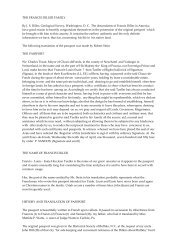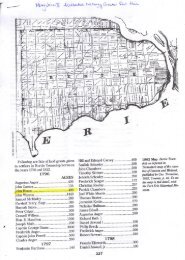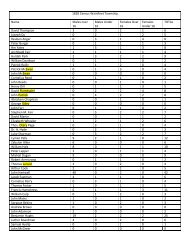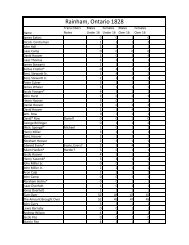Lutheran Trinity Church Stone Arabia, N. Y. - Crego-Jones Family ...
Lutheran Trinity Church Stone Arabia, N. Y. - Crego-Jones Family ...
Lutheran Trinity Church Stone Arabia, N. Y. - Crego-Jones Family ...
You also want an ePaper? Increase the reach of your titles
YUMPU automatically turns print PDFs into web optimized ePapers that Google loves.
LUTHERAN TRINITY CHURCH<br />
STONE ARABIA, NEW YORK.<br />
PRESENT<br />
LUTHERAN TRINITY CHURCH OF STONE ARABIA<br />
In 1860 certain changes were made in the original building and the<br />
alteration of the steeple somewhat changed its appearance. The<br />
chapel to the rear was added under Pastor W. F. Moot and during<br />
the present pastorate (Haverly) a kitchen was added at a cost of<br />
$1500. The parsonage to the rear right has undergone but slight<br />
change during the years it has stood there. A monument in front<br />
of the church (extreme right) bears a bronze tablet which faces the<br />
highway and reads as follows: "<strong>Trinity</strong> <strong>Lutheran</strong> <strong>Church</strong>, <strong>Stone</strong> <strong>Arabia</strong>.<br />
Site acquired June 2, 1729. Log church built by <strong>Lutheran</strong> and<br />
Reformed Palatines. A later church burned by Tories and Indians<br />
1780. Present building erected in 1792. Oldest <strong>Lutheran</strong> congregation<br />
in the Mohawk Valley. Erected by <strong>Church</strong> and State of New<br />
York, 1929."<br />
colonies, let us look briefly at the background of these people in<br />
Europe. It has been alleged that land speculators enticed them<br />
to leave the Rhine Valley playing upon their avarice. There<br />
is no doubt that political agents and colonial promoters and others<br />
who hoped to gain through them did approach them as such do.<br />
But the real motive cannot be hidden, nor minimized, nor diminished.<br />
People do not leave so fertile a land as the Palatinate<br />
for mere hope of gain coupled with unknown dangers and labors<br />
such as were before these refugees. They wanted freedom in the<br />
religion of their choice and the way opened through English<br />
friends and the new country beyond the sea.<br />
LUTHERAN TRINITY CHURCH OF STONE ARABIA, N. Y.<br />
As it appeared prior to 1860. This <strong>Church</strong> was erected in 1792<br />
It is not easy to grasp the horrible conditions that prevailed<br />
in Europe throughout the 17th century because of religious differences.<br />
For a hundred years the conflict raged, rising and<br />
falling in intensity with the turn of political and military fortunes.<br />
In the 30 Years' War it is estimated that the population<br />
of Germany decreased from twenty to fifty per cent. There had<br />
been 400,000 people in Wurtemberg. In 1641 only 48,000 remained.<br />
Women and children, the unarmed as well as the armed<br />
suffered from the brutal ferocity of the enemy. The Palatinate<br />
had not recovered from this catastrophe before the last decade in<br />
the century when religious intolerance burst forth with renewed<br />
fury.<br />
From a true account of the sad condition of the Protestants in<br />
the Palatinate in two letters to an English gentleman written in<br />
Heidelberg, Feb. 7, 1699 and printed in London that same year<br />
we glean a partial picture:<br />
"I agree with you that the Palatinate is one of the best<br />
countries in the world . . . But affairs at this time are<br />
such, that it cannot be expected that we should see it in that<br />
flourishing condition it formerly was when you saw it in your<br />
travels. During the war our hopes to have our condition bet-









